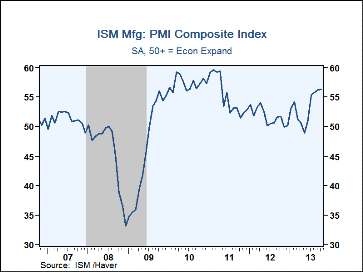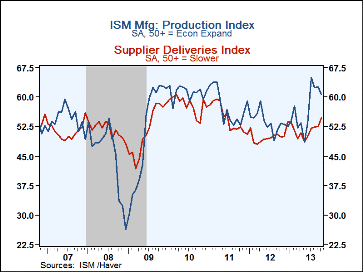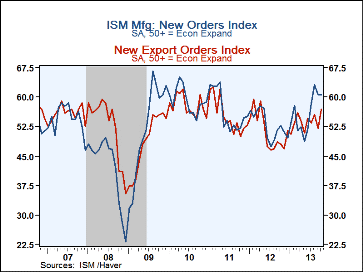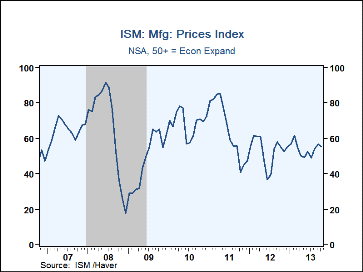 Global| Nov 01 2013
Global| Nov 01 2013U.S. ISM Index Nudges Higher While Prices Index Slips
by:Tom Moeller
|in:Economy in Brief
Summary
October was a constructive month for the manufacturing sector. The Composite Index of Manufacturing Sector Activity from the Institute for Supply Management ticked up to 56.4 from an unrevised 56.2 in September. The latest reading was [...]
October was a constructive month for the manufacturing sector. The Composite Index of Manufacturing Sector Activity from the Institute for Supply Management ticked up to 56.4 from an unrevised 56.2 in September. The latest reading was the highest level since April 2011. It beat expectations for a decline to 55.1, as measured by the Action Economics Survey. Any figure above 50 indicates an increasing level of activity in the factory sector. During the last ten years, there has been a 69% correlation between the ISM index and the q/q change in real GDP.
The inventories component again provided the greatest lift to the Composite Index as it rose to the highest level since August of last year. The supplier deliveries series index also rose, indicating the slowest delivery speeds since June 2011. New orders ticked up but the export orders series rose sharply to the highest level since April of last year. The factory sector employment series retreated to its lowest point since this past June. During the last ten years there has been an 88% correlation between the employment index and the m/m change in factory payrolls. The production index also dropped to it lowest level since June.
The prices paid index reversed roughly half of its prior month's gain but still was up versus the low three months ago. Twenty two percent of firms raised prices while 11 percent lowered them. During the last ten years there has been a 65% correlation between the index and the m/m change in the intermediate producer price index. The order backlog series increased to its highest level in six months.
The figures from the Institute For Supply Management (ISM) are diffusion indexes and can be found in Haver's USECON database. The expectations number is in the AS1REPNA database.
Taking Stock of the Labor Market Recovery from the Federal Reserve Bank of Cleveland is available here.
| ISM Mfg | Oct | Sep | Aug | Oct'12 | 2012 | 2011 | 2010 |
|---|---|---|---|---|---|---|---|
| Composite Index | 56.4 | 56.2 | 55.7 | 51.7 | 51.7 | 55.2 | 57.3 |
| New Orders | 60.6 | 60.5 | 63.2 | 52.8 | 52.9 | 56.4 | 59.2 |
| Production | 60.8 | 62.6 | 62.4 | 53.3 | 53.6 | 57.4 | 61.0 |
| Employment | 53.2 | 55.4 | 53.3 | 52.3 | 53.8 | 57.4 | 57.3 |
| Supplier Deliveries | 54.7 | 52.6 | 52.3 | 49.9 | 50.0 | 54.7 | 58.1 |
| Inventories | 52.5 | 50.0 | 47.5 | 50.0 | 48.2 | 50.1 | 50.8 |
| Prices Paid Index (NSA) | 55.5 | 56.5 | 54.0 | 55.0 | 53.2 | 65.2 | 68.9 |
Tom Moeller
AuthorMore in Author Profile »Prior to joining Haver Analytics in 2000, Mr. Moeller worked as the Economist at Chancellor Capital Management from 1985 to 1999. There, he developed comprehensive economic forecasts and interpreted economic data for equity and fixed income portfolio managers. Also at Chancellor, Mr. Moeller worked as an equity analyst and was responsible for researching and rating companies in the economically sensitive automobile and housing industries for investment in Chancellor’s equity portfolio. Prior to joining Chancellor, Mr. Moeller was an Economist at Citibank from 1979 to 1984. He also analyzed pricing behavior in the metals industry for the Council on Wage and Price Stability in Washington, D.C. In 1999, Mr. Moeller received the award for most accurate forecast from the Forecasters' Club of New York. From 1990 to 1992 he was President of the New York Association for Business Economists. Mr. Moeller earned an M.B.A. in Finance from Fordham University, where he graduated in 1987. He holds a Bachelor of Arts in Economics from George Washington University.










